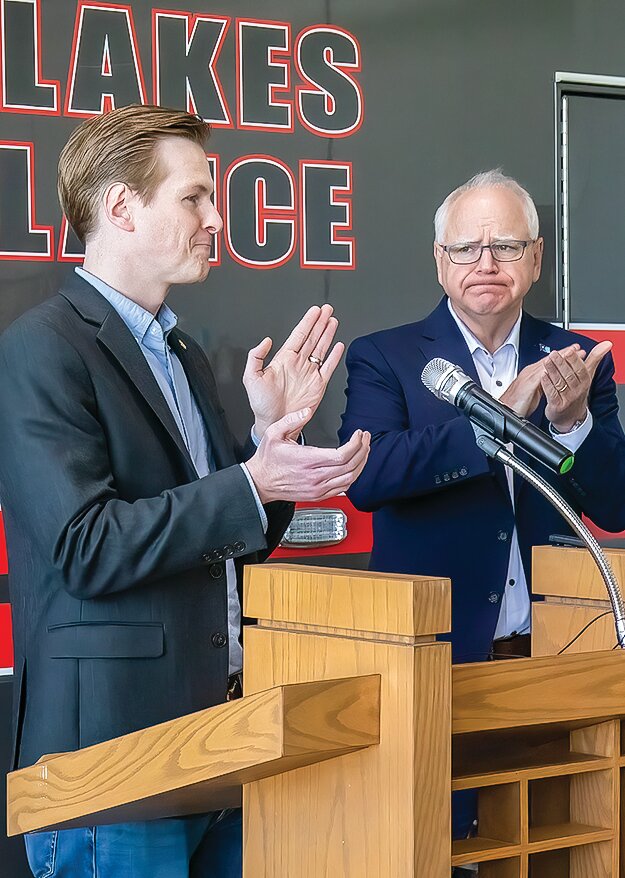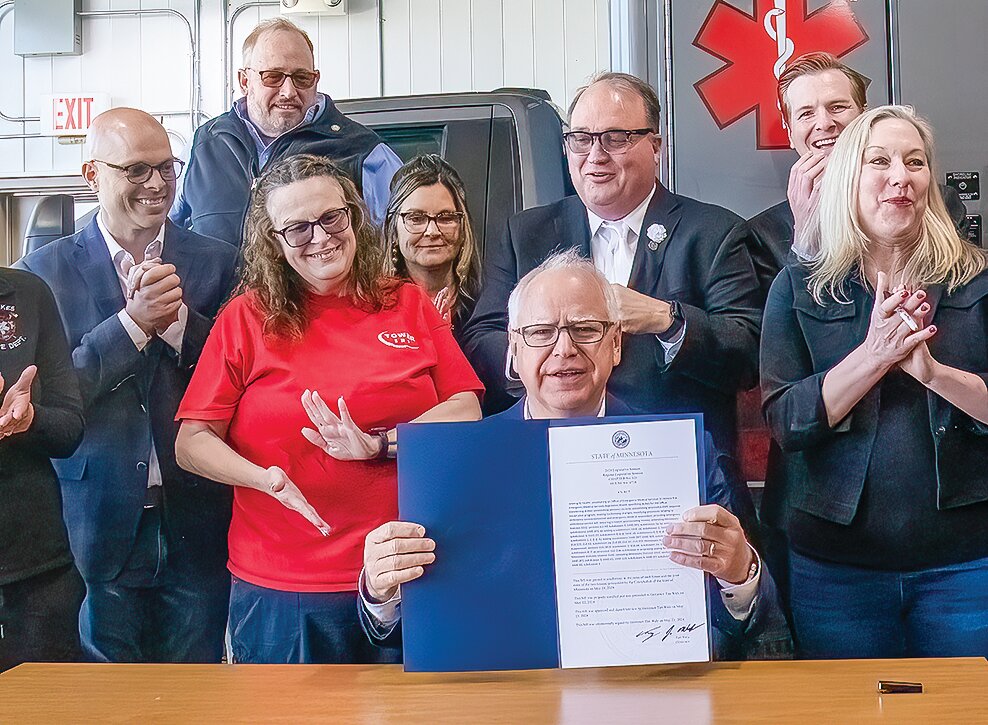Support the Timberjay by making a donation.
Walz inks EMS support bill on the Iron Range
Lawmakers praise local advocacy efforts
HOYT LAKES- Regional emergency medical services personnel came to Hoyt Lakes last Thursday, May 23, to join Gov. Tim Walz, Sen. Grant Hauschild and other legislators as Walz signed the bill that will …
This item is available in full to subscribers.
Attention subscribers
To continue reading, you will need to either log in to your subscriber account, below, or purchase a new subscription.
Please log in to continue |
Walz inks EMS support bill on the Iron Range
Lawmakers praise local advocacy efforts
HOYT LAKES- Regional emergency medical services personnel came to Hoyt Lakes last Thursday, May 23, to join Gov. Tim Walz, Sen. Grant Hauschild and other legislators as Walz signed the bill that will bring significant additional EMS funding to ambulance services across the North Country and elsewhere in Minnesota.
The bill included $24 million for EMS support through an amendment sponsored by Hauschild, who was pushing for additional funds even before the legislative session began.
“It was last year that we started hosting town halls all across the Iron Range, talking about the challenge that we face with EMS, and what I said from the beginning is that we’re not facing a challenge or a problem, we’re facing a true crisis in greater Minnesota, and especially here in northeastern Minnesota,” Hauschild told the assembly.
“We have further distances, we have an aging population, we have workforce challenges, we can’t get the volunteers that we used to be able to get because of rising costs for folks and families,” Hauschild continued. “We have to make sure that we’re investing in life saving care. When somebody calls 911 for a loved one or for themselves, regardless of where they live, they expect an ambulance and lifesaving care to show up.”
Hauschild talked about the additional challenges small rural communities face in having to operate EMS services themselves and pledged to keep working to bring more financial aid to the EMS system.
“We’re going to keep addressing this, we’re going to keep looking at the long term and how we can make sure we’re addressing the EMS crisis,” Hauschild said. “But for now, we’ve stopped the bleeding, and we’re going to keep going.”
Walz praised the EMS personnel for their input into shaping a bill that sets the stage for future improvements.
“Thank you again to all of you who lifted up their voice, participated in democracy, and made it clear that a priority for people across Minnesota was reliable EMS service in every corner of the state,” Walz said. “The system as it works right now simply doesn’t reimburse your work accordingly, and it was time for all of us collectively to step up and make that investment. I think it starts putting us on a course with more sustainable ability to recruit, retain and equip EMS across the state.”
Sen. Judy Seeberger, co-chair of the legislature’s Emergency Medical Services Task Force and co-author of the bill signed by Walz, noted her personal connection to the EMS issue.
“I’m not just a senator, I’m a paramedic,” Seeberger said. “I work for an ambulance service, and I’m also on a paid on-call fire department. I see what it’s like out there, boots on the ground everyday doing what we do. And I can honestly say, and all of my colleagues in EMS will agree, that we do it because we love it. It’s an honor to be there. I think that’s why everybody does it. But we can’t ignore the realities of the financial difficulties that our ambulance services are in, particularly here in greater Minnesota. So, I’m so pleased at the work that we’ve done on the task force. It’s been something that has been needed to be addressed and has needed attention for so long.”
Task force co-chair and bill co-author Rep. John Huot followed up on Seeberger’s remarks by reiterating how important the work of North Country EMS personnel was in creating the bill and getting it passed.
“What you did up here, the whistle you blew, is going to make a big change throughout the state,” Huot said. “And what the governor kind of told me earlier was that this may make a big change throughout the country, because what we’re doing here, no one else is doing.”
Rep. Dave Lislegard said he was proud of the contributions that came from East Range EMS service and reiterated his commitment to continue the fight for more EMS support.
“This isn’t just a one and done, get the money out and move on, right?” he said. “This is about fundamental and structural change, because what worked 20 or 30 years ago doesn’t work anymore, so we have to look at it differently and we have to respond to the needs of the people.”
Rep. Roger Skraba, delayed by an accident that required an EMS response, arrived midway through the event and got the most enthusiastic laugh of the day when he said, “It’s hard to drive 55 when you know you’re going to be late for the governor.”
Skraba highlighted the bipartisan nature of getting something done.
“With Grant and Dave, we all were like we have to do something, so let’s have this conversation. What is essential, what isn’t? Obviously, I think you all got the ears of all of us, so where we go from here is going to be collectively between you and us.”
After Walz signed the bill, he also talked about the bipartisan process for the Timberjay.
“I think people should recognize that the work got done, the proof is in the pudding,” Walz said. “These folks worked together and most every piece of the bill that came out at the end of the session was bipartisan, voted on by both sides. I think it’s much more the process and things that irritates people, but the product is a good one.”
Tower Ambulance Director Dena Suihkonen offered her thoughts following the signing.
“Having the governor up here is pretty darn exciting,” she said. “We’ve been very lucky that Grant’s been working with us quite a bit. He’s been very easy to talk to, as has Rep. Huot. So, as you could probably see when he was talking, he was looking right at me because I was a pain in the butt, but I think that’s how we have to get them involved, telling them about our weaknesses, our strengths, and what we need their help on. We have parents who are older, we have children, we have all of these people that need these services. Minnesota can make changes and come up with ideas that can help the whole country. I am just accepting that this is the first step of hopefully a lot of steps in order to make sure that we have sustainable EMS, especially on the Range.”
In addition to the $24 million of supplemental aid, the bill also provides $6 million to fund a “sprint medic” pilot program in St. Louis County as well as two west-central Minnesota counties. The pilot program is designed to test the effectiveness of using roving paramedics who would operate across the boundaries of up to several ambulance coverage areas and would respond in personal vehicles to medical calls, in hopes of improving response time and the level of care that can be provided to patients at the outset of that response.









